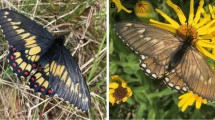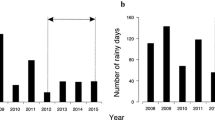Summary
Morphological analyses were conducted on finch species introduced to Oahu, Hawaii. As many as 25 species of finches representing four families (Emberizidae, Fringillidae, Ploecidae, Estrildidae) have been introduced to Oahu. Of these, 15 species currently have established wild populations. When compared with pools of 25 and 23 species introduced to Oahu, the 15 surviving species are morphologically overdispersed. This result is consistent with the hypothesis that competition has influenced the outcome of these introductions. We also tested the hypothesis that surviving introduced finches in one habitat (sugarcane fields) were morphologically overdispersed. When the seven surviving finch species found in sugarcane were compared with the pools of 25 and 23 species, they too were morphologically overdispersed. However, when the seven sugarcane species were compared with a species pool consisting of only the surviving 15 species found across Oahu, they were not morphologically overdispersed. This result suggests that morphological analyses of community structure based only on comparisons of assemblages of surviving species may be biased by a Narcissus effect.
Similar content being viewed by others
References
Abbott, I., Abbott, L. K. and Grant, P. R. (1977) Comparative ecology of the Galapagos ground finches (Geospiza Gould): evaluation of the importance of floristic diversity and interspecific competition.Ecol. Monogr. 47, 151–84.
Ashmole, N. P. (1968) Body size, prey size, and ecological segregation in five sympatric tropical terns (Aves: Laridae).Syst. Zool. 17, 292–304.
Benkman, C. W. and Pulliam, H. R. (1988) The comparative feeding rates of North American sparrows and finches.Ecology 69, 1195–9.
Berger, A. J. (1981)Hawaiian Birdlife, 2nd edn. University Press of Hawaii, Honolulu, USA.
Bowers, M. A. and Brown, J. H. (1982) Body size and coexistence in desert rodents: chance or community structure.Ecology 63, 391–400.
Case, T. J., Faaborg, J. and Sidell, R. (1983) The role of body size in assemble of West Indian bird communities.Evolution 37, 1062–74.
Caum, E. L. (1933),The Exotic Birds of Hawaii. Vol. 10, pp. 1–55. Occasional Papers, Bernice P. Bishop Museum.
Colwell, R. K. and Winkler, C. W. (1984) A null model for null models in biogeography. InEcological Communities: Conceptual Issues and the Evidence (D. R. Strong Jr, D. Simberloff, L. G. Abele and A. B. Thistle, eds) pp. 344–59. Princeton University Press, Princeton, NJ, USA.
Conant, S. (1984) First Oahu record of Warbling Silverbill.Elepaio 44, 116.
Findley, J. S., (1973) Phenetic packing as a measure of faunal diversity.Am. Nat. 107, 580–4.
Findley, J. S. (1976) The structure of bat communities.Am. Nat. 110, 129–39.
Goodwin, D. (1982)Estrildial finches of the world. Cornell University Press, Ithaca, NY, USA.
Grant, P. R. (1986)Ecology and Evolution in Darwin's Finches. Princeton University Press, Princeton, NJ, USA.
Karr, J. R. and James, F. C. (1975) Ecomorphological configurations and convergent evolution in species and communities. InEcology and Evolution of Communities (M. L. Cody and J. M. Diamond, eds) pp. 259–91. Harvard Press, Cambridge, MA, USA.
Lack, D. (1976).Island Biology Illustrated by the Land Birds of Jamaica. University of California Press, Los Angeles, GA, USA.
Long, J. (1981)Introduced Birds of the World. David and Charles, London, UK.
Miles, D. B. and Ricklefs, R. E. (1984) The correlation between ecology and morphology in deciduous forest passerine birds.Ecology 65, 1629–40.
Moulton, M. P. and Pimm, S. L. (1983) The introduced Hawaiian avifauna: biogeographical evidence for competition.Am. Nat. 121, 669–90.
Moulton, M. P. and Pimm, S. L. (1986) The extent of competition in shaping an introduced avifauna. InCommunity Ecology (J. Diamond and T. J. Case, eds). Harper and Row, NY, USA.
Moulton, M. P. and Pimm, S. L. (1987) A morphological assortment in introduced Hawaiian Passerines.Evol. Ecol. 1, 113–24.
Mountainspring, S. and Scott, J. M. (1985) Interspecific competition among Hawaiian forest birds.Ecol. Monogr. 55, 219–39.
Newton, I. (1967) The adaptive radiation and feeding ecology of some British finches.109, 33–98.
Pratt, H. D., Bruner, P. and Berrett, D. G. (1987)A Field Guide to the Birds of Hawaii and the Tropical Pacific. Princeton University Press, Princeton, NJ, USA.
Pyle, P. L. (1977) Recent observations of birds on Oahu. August 1976 to February 1977.Elepaio,38, 2–7.
Raffaele, H. A. (1983)A Guide to the Birds of Puerto Rico and the Virgin Islands, Fondo Educativo Interamericano, San Juan, PR, USA.
Ricklefs, R. E. and Travis, J. (1980) Morphological approach to the study of avian community organization.Auk 97, 321–38.
Schluter, D. (1988) The evolution of finch communities on islands and continents: Kenya vs. Galapagos.Ecol. Monogr. 58, 229–49.
Scott, J. M., Mountainspring, M., Ramsey, F. L. and Kepler, C. B. (1986)Forest Bird Communities of the Hawaiian Islands: Their Dynamics, Ecology, and Conservation. Allen Press, Inc. Lawrence, KS, USA.
Simberloff, D. S. (1990) Free-living communities and alimentary tract helminths: hypotheses and pattern analyses. InParasite Communities: Fatterns and Processes (G. Esch, A. Bush and J. Aho, eds) pp. 289–320. Chapman & Hall, NY, USA.
Simberloff, D. S., and Boecklen, W. (1991) Patterns of extinction in the introduced Hawaiian avifauna: a reexamination of the role of competition.Am. Nat. (in press).
Travis, J. and Ricklefs, R. E. (1983) A morphological comparison of island and mainland assemblages of neotropical birds.Oikos 41, 434–41.
Watling, D. (1982)Birds of Fiji, Tonga, and Samoa. Millwood Press, Wellington, New Zealand.
Willig, M. R. and Moulton, M. P. (1989) The role of stochastic and deterministic processes in structuring neotropical bat communities.J. Mammol. 70, 323–9.
Wilson, D. S. (1975) The adequacy of body size as a niche difference.Am. Nat. 109, 769–84.
Author information
Authors and Affiliations
Rights and permissions
About this article
Cite this article
Moulton, M.P., Lockwood, J.L. Morphological dispersion of introduced Hawaiian finches: evidence for competition and a Narcissus effect. Evol Ecol 6, 45–55 (1992). https://doi.org/10.1007/BF02285333
Issue Date:
DOI: https://doi.org/10.1007/BF02285333




